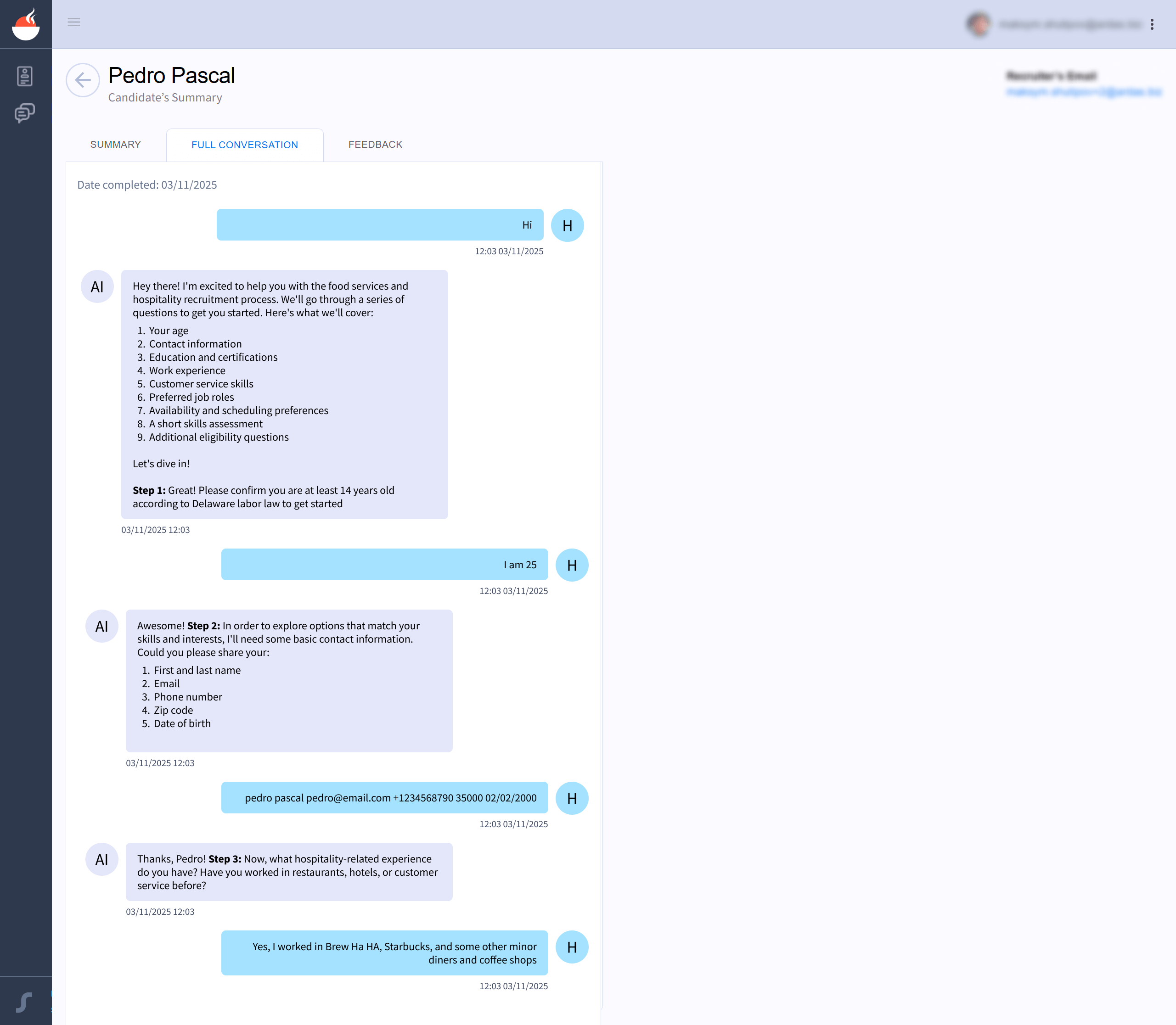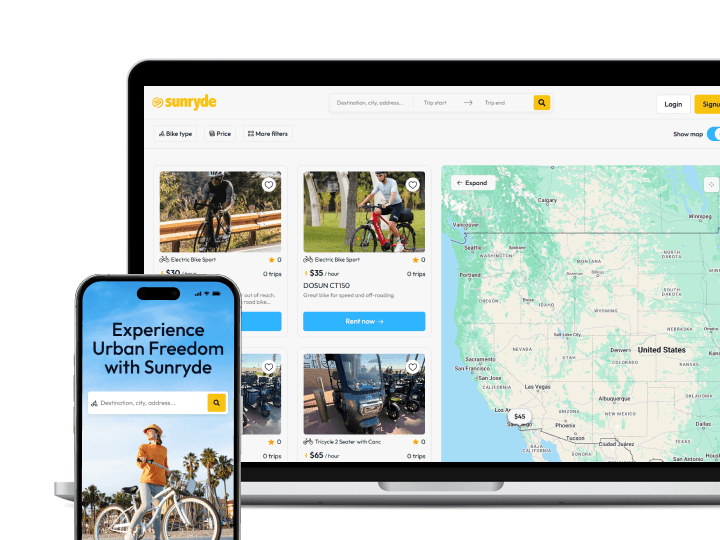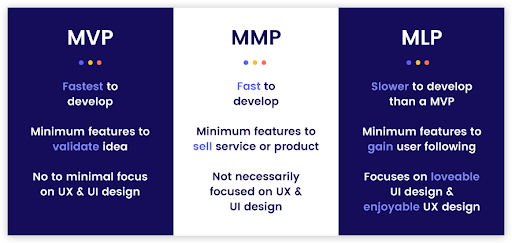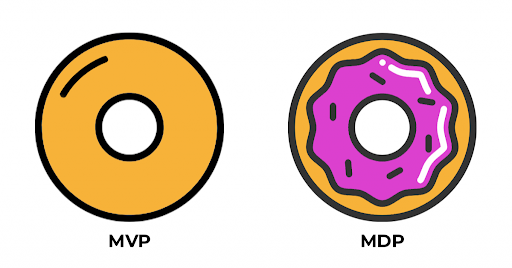MVP vs MDP vs MMF vs MLP: What Modern Startups Need to Know
When creating and developing any IT product, there are always people from technology and people from the business. Both categories are somehow familiar with MVP development, with the only caveat that the latter is much larger than the former. What about MDP, MMF, and MLP? We’ll figure it out.
Launching a digital product isn't just about quickly getting something out the door. It’s about launching something people want to use, keep using, and talk about. That’s why product development strategies are evolving fast. While the Minimum Viable Product (MVP) has long been the go-to framework for startups, 2025 is all about building Minimum Desirable Products (MDP) and beyond.
But there’s more. To truly understand what’s right for your product, you also need to consider MMF (Minimum Marketable Feature) and MLP (Minimum Lovable Product). These models are changing how startups think about product strategy, validation, design, and growth.
Let’s break down each one and how they fit into your product’s journey from an idea to a must-have solution.
Main Stages of Startup and Enterprises Development
Knowing where you are along the continuum is useful, particularly for early-stage startups. Your position can help investors, partners, prospective employees, and others assess your current growth and potential for success.
Fundraising throughout the process is always challenging, so start with a solid idea, a clear business plan, and a strong founding team, and your probability of success increases.
And while MVPs are often associated with early-stage startups, they're not exclusive to them. More mature companies use MVP development, too — whether they’re testing new features, entering new markets, or validating product extensions. It's still one of the most efficient ways to reduce risk and learn fast.
MVP: The Leading Starting Line
Reading news about projects and services, you often come across the concept of MVP. But what is hidden under this abbreviation and why is MVP so often used at the initial stages of product development? Let's figure this out together right now.
What is an MVP?
A Minimum Viable Product (MVP) is like a test version of a product or service, containing the fewest necessary features, sometimes even just one, to provide value or gather feedback from users. Typically identified during the initial stages of product discovery, an MVP serves as a foundational prototype for further development and refinement.
Purpose of an MVP
MVPs are created to test hypotheses and test the viability of the intended product, and how valuable and in demand it will be on the market.
The results of testing the minimum viable product and feedback from the target audience help to understand whether it is worth developing the project further, what changes should be made to the strategy, and what should be left in its original form.
Key Characteristics of MVPs
- Core functionality only
- Fastest time-to-market
- Cost-effective and lean
- Built to validate product-market fit
MVP Development Process
- Determination of the basic principles for creating an MVP.
- Finding a real problem that MVP will solve.
- Search for the target audience.
- Identification and analysis of the main competitors.
- Conducting a SWOT analysis.
- Create a user journey map.
- Compiling a list of product features.
- Scoping the MVP.
- Choice of management and development method.
- Conducting testing, like User Acceptance Testing (UAT)
After going through 10 stages, you will get a good minimum viable product, which will later develop into the first version of a full-fledged project. And do not be afraid to make changes: abandon some stages, add your own, etc. This sequence of steps is not a strict rule but only an example or template from which you can build something of your own and unique.
Need expert advice on where to start with MVP for your business idea?
Contact us now to discuss your ideas and current business needs to start working on MVP.
MVP in Action
Large companies' examples prove the usefulness of developing an MVP. For example, Daniel Ek and Martin Laurenson launched a small service in 2006 with one function: music streaming. Today, their product—Spotify —is valued at $21 billion, collaborates with major recording studios, and has an active audience of 50 million people.
In 2008, when renting a hotel or accommodation while traveling was a big problem, two enthusiasts decided to go outside the box and rent out their apartments via simple fax. This is also an MVP in which the primary function was tested. The experiment showed that the product would be in demand, and today Airbnb is one of the largest platforms for finding short-term rental housing.
Case Study: AI Assistant for Hospitality Recruitment (UAT Phase)
We developed an MVP of an AI-powered assistant using a multi-agent system and n8n workflow automation to streamline recruitment in the hospitality sector. Right now, we’re in the User Acceptance Testing (UAT) phase, where real users validate the product’s functionality, usability, and business fit, crucial for shaping the final version.

The goal? Solve hiring bottlenecks like outdated processes, low candidate engagement, and the hassle of managing qualifications and documentation.
This solution isn't limited to hospitality alone. In complex industries like healthcare, where compliance, certifications, and specialized roles add layers of difficulty, this AI-driven approach can be adapted to automate evaluations, track credentials, and boost recruitment efficiency.
Built on a modern stack, the MVP is scalable, integration-ready, and highly customizable.

Need more details about this product?
Find out more about intelligent AI assistant development.
Check it now.
MDP: Designing for Retention, Not Just Validation
What is an MDP?
The Minimum Desirable Product builds on MVP fundamentals but layers in user delight. In 2025, simply working isn't enough—products must feel good to use.
Key Characteristics of MDPs
- Refined UX/UI from day one
- Focus on seamless experiences
- Designed for engagement and retention
- Strong emotional connection with users
MDP in Action
Notion didn't stop at "working." It offered a clean, intuitive design and collaborative tools that made users fall in love early on—even before it was fully built out.
Case Study: Sunryde – From MVP to MDP
Sunryde, a Los Angeles-based urban mobility startup, began with a functional MVP.

- Basic bike rental platform
- Manual confirmation for bookings
- Stripe-based payments
The problem? It worked, but it didn't excite users. Users dropped off quickly due to the lack of convenience and polish.
The Pivot to MDP:
- Real-time availability for seamless bookings
- Mobile-first responsive design
- Automated Admin dashboard
- AI-powered recommendations
The Outcome
- Higher retention and engagement
- Positioned as a top-tier solution in urban mobility
- Scalable infrastructure for long-term growth
Why MDPs Matter for Startups
In an attention economy, an MVP might help users try your product. But an MDP helps them stay.

Need more details about this product?
Find out more about urban mobility marketplace development. Check it now.
MMF: Delivering Real Value, One Feature at a Time
What is an MMF?
A Minimum Marketable Feature is the smallest piece of functionality that can provide value to users and the business on its own. It's a building block of a larger solution but usable and marketable independently.
Use Cases:
Think of MMFs as app updates or feature releases—small but meaningful additions like adding dark mode or voice search.
Key Advantages:
- Faster delivery cycles
- Keeps users engaged post-launch
- Focuses on value per release
MMP and MMR: The Bridge to Monetization
The next stages in the project development are Minimum Marketable Product and Minimum Marketable Release.
What is MMR and What is MMP and Why They Matter
MMP (Minimum Marketable Product)
It's the first complete version of your product that's ready to be sold to customers. It includes a basic set of marketable features—not just validation or delight, but monetization.
MMR (Minimum Marketable Release)
It's a deployable package of MMFs that make up an MMP. As your product grows, you might have multiple MMRs, each building on the last.
Why They Matter:
MMP and MMR define the moment your product goes from "promising" to "profitable." Apple's first iPhone was a textbook MMP—it didn't have every feature, but it nailed the essentials and sold millions.
MMF features 1 + MMF feature 2 + MMF feature 3 = MMR
It is possible to have a second MMR if the product must evolve to meet new needs.
MMP and MMR Examples
An example of a minimal marketable product is the original iPhone, launched in 2007. One of the secrets behind its success is the narrow set of customer needs Apple selected. The company avoided the trap of trying to please too many people at once, of trying to copy all the features competitors offered.

MLP, MDP, MAP: The End Game of Modern UX
These startup process acronyms stand for minimum loveable, minimum delightful, and minimum awesome product, respectively.
What are MLP, MDP, and MAP
- MLP or a minimum loveable product takes the MMP and adds new cool features that your customers will love. This removes the "dullness" often associated with MVPs and MMPs and adds bits and bobs that give your product a "daily use" capability. MLPs offer an innovative user interface and a better user experience that is both reliable and functional.
- MDP or a minimum delightful product furthers your MLP and adds some wow factor. An MDP has the wow potential to woo your investors and audiences with a product that is an absolute delight.
- MAP or a minimum awesome product adds a world-class user interface, the most-requested enhancements and functionalities that give it a definite edge over an MDP.
Purpose of MLP, MDP, and MAP
This is the final iteration of a lean product that is closest to a full-fledged commercial product. This product will have every requested feature, an outstanding and well-polished user interface, and offer a world-class user experience to your target audience.
MLP, MDP, and MAP Examples
In short, this is the product your users will want to use daily and tell their friends about— similar to Uber, Instagram and many others.
As an entrepreneur, you may face the dilemma of launching your product or waiting until it's polished enough.
As a lean startup, you can use the power of iterative development and constant updates to keep your customers engaged and satisfied as you improve the product across releases.
Comparison Table: MVP VS MDP VS MMF Vs. MLP
We made it simpler for you to navigate these abbreviations and see the difference between MVP in software development and other terms.
|
Type of product |
Stands for |
Development Speed |
Minimum Features |
Price |
Built on |
| MVP | minimum viable product | fastest | to test the idea | cheapest | idea |
| MDP | minimum desirable product | fast | to sell the product | cheap | several MVPs |
| MMF | minimum markketable feature | fast | to bring immediate value to users | depends on features | feature description |
| MLP | minimum lovable product | slower than MVP | to entice the wow-effect | depends on features | MVP concept |
What Works Better for You, MVP or MDP?
Choose MVP if… You're validating a risky idea with limited budget
- You need to launch and learn quickly
- You're comfortable refining post-launch
Choose MDP or MLP if… You're entering a competitive space
- You want to retain users from day one
- UX and emotional engagement are key to your value prop
Choose MMF if… You want to ship valuable features fast
- Your product is already in-market but evolving
- You're adding monetizable enhancements
Here are some more examples to help understand the difference between MVP and MDP:
- If you've built a game with an impressive viral effect but a terrible churn rate, then you've built an MVP, not an MDP.
- If you have a profitable dating service that generates tons of users who end up signing up for a monthly subscription for 20 bucks, but none of them get the promised hot nights, then you have built an MVP, not an MDP.
- If you invented a magic box that spits out a $100 bill every time you press a button (there is no button in the free version, haha), then this is a desirable product but not viable, that is, it is an MDP, not an MVP.
- If you've created an amazing board game that your friends and family are playing passionately, but haven't found a publisher to distribute it, then you've created an MDP, not an MVP.

Wrap Up: It's Not MVP vs. MDP—It's How You Combine Them
In 2025, building a great product isn't just about what works—it's about what sticks.
Start with an MVP mindset to launch fast. But don't stop there. Layer in MDP thinking to retain users. Use MMFs to grow smart, and aim for an MLP or MAP when you're ready to stand out at scale. Smart startups know: the future isn't about one acronym—it's about mastering the evolution from MVP to awesome.
Nevertheless, suppose you are interested not only in understanding terminology but also in implementing these stages in your project. In that case, our team is ready to accompany you at every stage of MVP development services.
